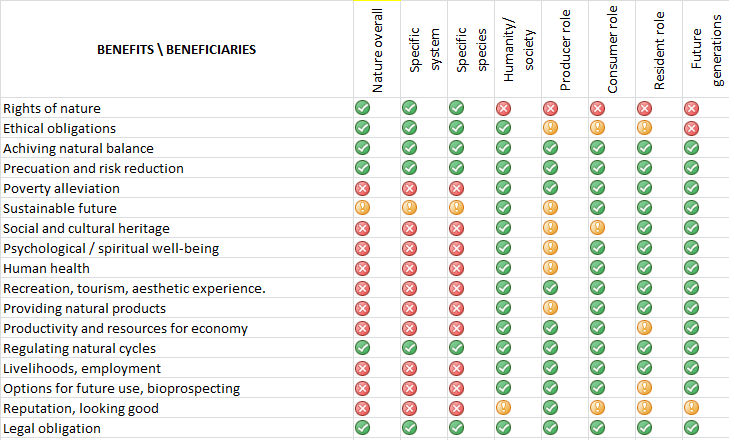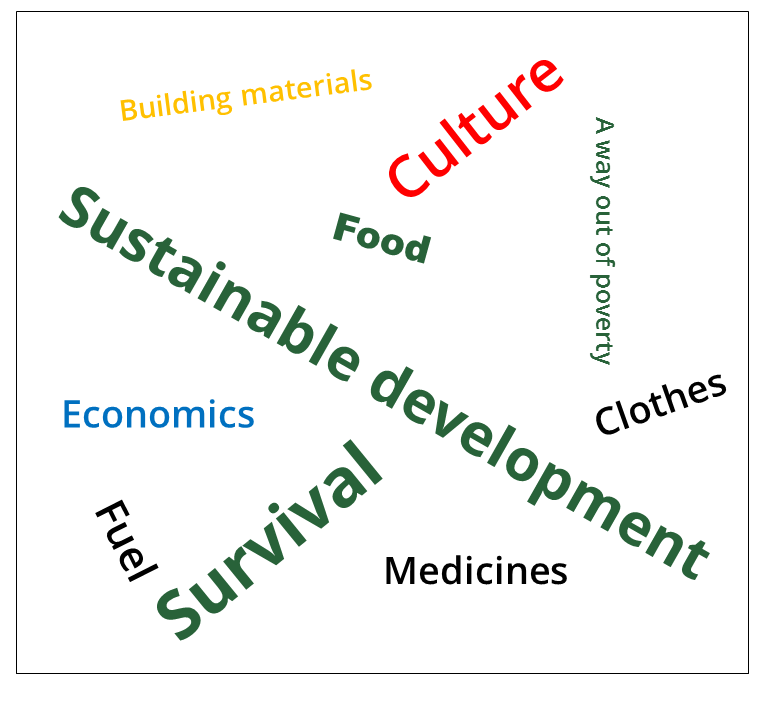DRAFT VERSION![]() Intended audience
Intended audience
This brief is aimed at policy-makers, decision-makers, land managers, and the public or everyone looking for information on the benefits of biodiversity protection.
The benefits of biodiversity
There are many reasons for conserving biodiversity. One way to think about these, and to construct arguments for conservation, is to consider the benefits that biodiversity brings, to people and to the natural world. The BESAFE project developed a list of basic arguments (see Figure 1). There are many other ways arguments could be described: these 17 arguments were chosen to be comprehensive while retaining a practicable number , and each is explained in more detail in a BESAFE brief. The arguments can be grouped in different ways, for example:
- Some reasons relate to satisfying obligations or cultural norms of behaviour. These range from recognition of the intrinsic values of nature itself, through human obligations as custodians of nature, to simply legal obligations to avoid damage.
- Others focus on the role of healthy ecosystems as a means of achieving sustainability and reducing risks, regulating natural cycles.
- A third group focuses on the ways humans interact directly with nature, with benefits including recreation, cultural meanings, mental or physical health improvements, and consumption of ‘natural’ products.
- Other arguments focus on the role of biodiversity in supporting economic activity, jobs and livelihoods, and maintaining options for future possible uses of biodiversity
These benefits are not mutually exclusive, and can be complementary. On the other hand, there are often trade-offs whereby some forms of benefit (recreation, food production…) conflict with others (pristine nature, water supply…). Other BESAFE briefs explain how to evaluate different benefits and how to deal with trade-offs in constructing arguments for conservation.
Beneficiaries of biodiversity
The benefits identified above can accrue at different levels to different beneficiaries. Sometimes, the beneficiary is nature itself, or a specific part of it. These beneficiaries match with the arguments about intrinsic rights and human obligations to nature. Often, human beneficiaries are identified, whether humanity in general, now and/or with explicit reference to future generations, or more specific groups of people. Groups can be roughly divided into ‘residents’ (local people and landowners), ‘producers’ (e.g. farmers and industrial users) and ‘consumers’ (e.g. recreational users, hunters, buyers of natural products). In any specific case, stakeholders may be identified in much more detail, and arguments often need to be sensitive to conflict and trade-off between the interests of different groups.

Using the classification
Understanding what the benefits from the protection of biodiversity are and who gains from the protection of biodiversity is important for developing argument strategies for conservation. Each different combination of benefit and beneficiary has the potential to create a separate argument, and tailoring arguments to the interests and concerns of different stakeholder groups can be highly effective (see Briefs on tailoring for audience and the effectiveness of arguments.
Transferability
Different strategies are used in different cases, depending on interests/stakes of decision makers. BESAFE findings show that local people are often more concerned with provisioning services and the associated socio-economic benefits (jobs and income from farming, fishing, timber etc.), though they often also place a high value on cultural heritage and the local distinctiveness of the area. Governments and regulators tend to be more aware of regulating services (water, air, climate, soil). Tourists may be more concerned with cultural, recreational, landscape and aesthetic benefits, and species abundance for charismatic species, though some may recognise the importance of regulating and supporting services in providing these benefits.
Similar arguments may be expressed in very different ways depending on context and expectations of audiences. For example, managing agricultural/livestock impacts on natural resources is a common issue. In argumentation about UK catchment management, the water industry regulator Ofwat requires water companies to provide cost-benefit analysis (CBA) and evidence of customer preferences. In the case of the Doñana national park (Spain), the focus of argumentation is on cultural values associated with unique ecosystems, endemic species, and traditional cultural practices. The dominant arguments are not economic, but rather relate to the importance of conservation, controlling the impact of grazing on wetlands and biodiversity, while recognising the importance of conservating native livestock breeds.
Since different benefits accrue to different stakeholder groups, conflicts often arise. These can relate to benefits within an area, or impacts outside; and they may be more negotiable or fundamental. For example, agricultural practices can lead to poor water quality downstream, eutrophication and reduced fisheries productivity, but there is room for negotiation and helping or compensating farmers to introduce less damaging methods (as in the UK catchment management case).
Where conflicts relate to fundamental disagreements over appropriate trade-offs, there may be less room for negotiation. For example, reintroducing species to the wild is generally very controversial: the “large mammal conservation” case study of the return of large carnivores to Norwegian wild-lands has given rise to a heated debate over nature management, biodiversity protection, and the associated conflicting interests concerning the different uses of the Norwegian wild-lands. Coastal realignment is another area where fundamental conflicts may be difficult to resolve. It should be recognised that, in some cases, conservation will inevitably damage some stakeholders’ interests. It may not be possible to present arguments for benefits to these stakeholders. Strategies here could focus on possible compensation for the losers, where appropriate, on arguments about “greatest good to the greatest number”, or on future-focused moral obligations to conserve.
Lessons learned
- Biodiversity protection can be thought about in terms of the many different benefits it brings. Benefit-beneficiary pairings are the fundamental underpinnings of argumentation for biodiversity: conserving biodiversity will achieve [BENEFIT] for [BENEFICIARY].
- Different combinations of benefits and beneficiaries can be put together to construct a strategic argument for persuading audiences of the advantages of conservation.
- Often, utilitiarian and moral arguments can be mutually supportive: an argument strategy can appeal to selfish motives (benefits to particular groups) and also to ideas of ‘doing the right thing’ for nature, the less fortunate and future generations.
- Some conflicts may be quite intractable, and if some stakeholders will lose out, this must be recognised. Argument strategies can focus on the greater benefit to others (possibly backed up with compensation) and on moral obligations to future generations and nature itself.
Looking for more information on effective arguments for biodiversity?
For more BESAFE results, including separate briefs focusing on other case studies and various aspects of argumentation, see http://www.besafe.pensoft.net [ref BESAFE toolkit].
This brief is a result of research carried out under the BESAFE project. This brief was written by Dr Rob Tinch and Laurence Mathieu at www.eftec.co.uk. Further information is available at (website, report, publication…)
The BESAFE project is an interdisciplinary research project funded under the European Community’s Seventh Framework Programme, contract number: 282743.
http://www.besafe.pensoft.net/ | rob@eftec.co.uk
